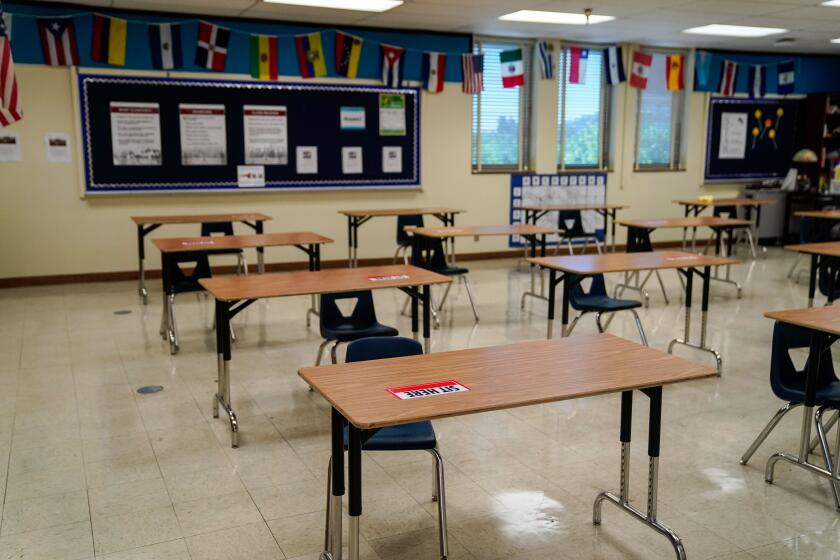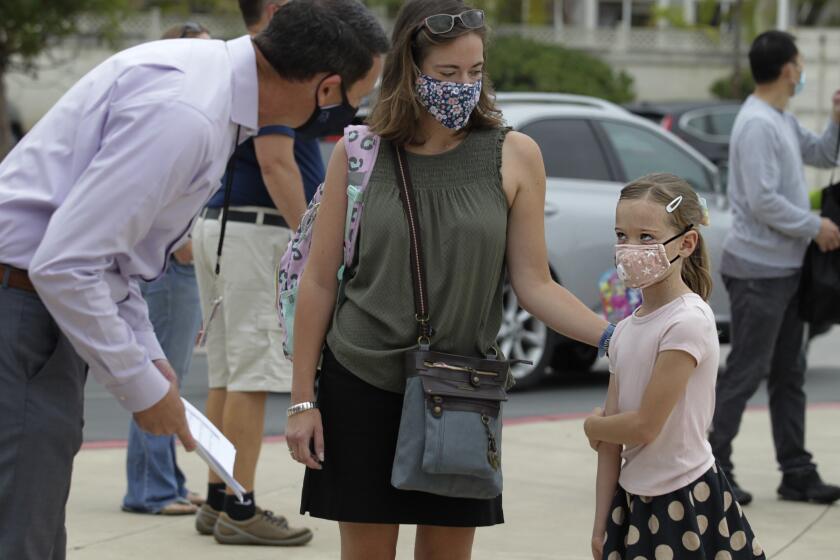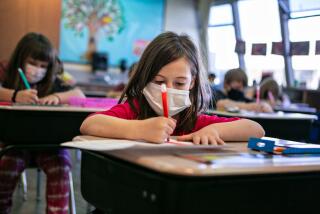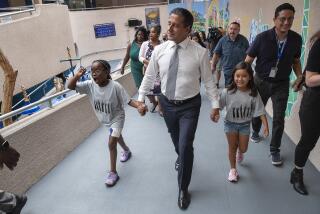Tens of thousands of L.A.-area students still need computers or Wi-Fi 6 months into pandemic
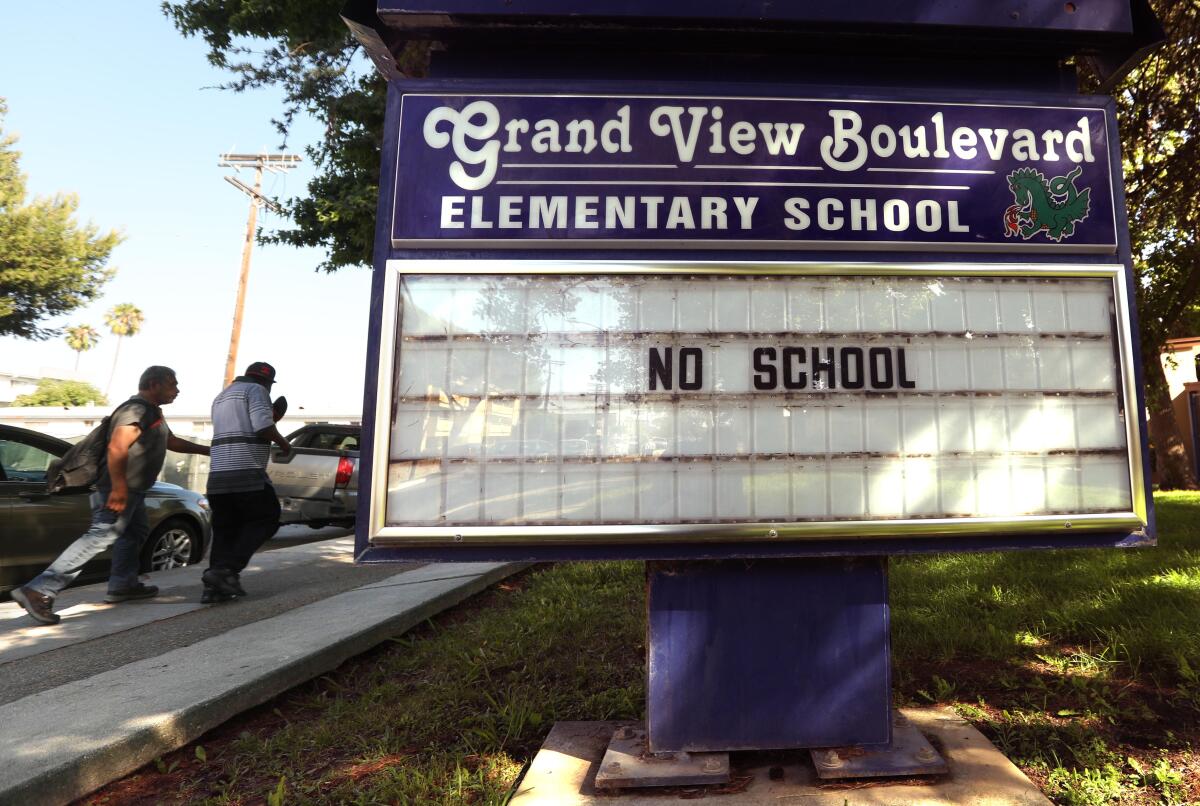
- Share via
Six months after schools closed amid the coronavirus crisis and with online learning in full swing, tens of thousand of students remain without adequate digital access and school districts in Los Angeles County report they still need nearly 50,000 computers and Wi-Fi hot spots.
The numbers are a stark reminder that technology access continues to pose a significant barrier to distance learning as schools in Los Angeles County will not be allowed to fully reopen until at least November.
For the record:
12:58 p.m. Sept. 21, 2020And earlier version of this story said Compton Unified had requested 1,500 hot spots from the Los Angeles County Office of Education. The district said it had asked for 1,500 iPads with built-in internet capability.
“I’m very concerned if there’s even a small fraction of students who aren’t accessing, especially when we’re talking about students who are already more vulnerable and disadvantaged,” said Debra Duardo, superintendent of the L.A. County Office of Education. “There is already a gap, whether you want to call it an academic gap or an opportunity gap. There is already a gap, and we don’t want that gap to get any larger.”
The Office of Education, which provides services and financial oversight for the county’s 80 school districts, released the numbers Tuesday, the same day that the L.A. County Board of Supervisors voted to approve $14.9 million in spending to help close the technology gap. Duardo’s office had requested the funding based on a survey of needs in local school systems.
Some district officials told The Times they have not yet been able to distribute computers and hot spots to every student who needs them. Others have distributed the devices and hot spots to all students but said that inadequate technology, outdated equipment and other problems have at times made it difficult or impossible for children to use the devices.
The need is even more acute now compared with the spring, when schools initially closed, because new state education policy has made online learning more rigorous for this academic year — with full schedules, mandatory attendance and heightened expectations for students. At the same time, massive backlogs in supply have made it impossible for many districts to secure the computers and hot spots on their own.
The new school year of remote learning will bring unique challenges. Here are guides to help parents of school-age children navigate remote learning, as well as recent updates about education in Southern California.
In the Palmdale School District, about 2,000 kindergarten students still need iPads, said Jim Smith, manager of information services.
For now, families that can’t get a school-issued device are being urged to use any computers they have in the home, and when all else fails, the district sends paper packets home, he said.
“It’s a big concern,” Smith said. “It’s probably one of our primary issues and concerns right now.”
The district also needs newer Chromebooks because many of the ones that have been issued to students are about 4 or 5 years old, Smith said.
“It’s not that those students don’t have anything available to them, it’s that it’s not adequate,” Smith said. “When we send them home for distance learning they don’t perform as well as the modern units. So you see things like dropped calls or jittery audio.”
In some cases, district leaders say the computers they distributed were never meant to be used outside the classroom, creating challenges for home users. In other cases, computers have been damaged or lost.or the hot spots school officials have are inadequate or simply don’t work in certain places.
“Our kids have access but it’s very fragile,” said Lillian Maldonado French, superintendent of Mountain View School District in El Monte. “We really are hoping to have a better, more stable solution for our community.”
San Diego County has gotten the green light to reopen schools, and Orange County officials believe they’ll soon be allowed to follow. But the picture on a school district level is far more complicated.
Compton Unified School District Supt. Darin Brawley said that while it took time to distribute technology in the spring — partly due to delayed orders — Compton ultimately met their needs. Still, the district now needs about 3,500 laptops and 1,500 iPads with built-in internet. The iPads would replace hot spots that don’t provide an adequate connection for students.
“We had hot spots, but the ones we are using were not solving the issue of connectivity,” Brawley said. “Our kids are struggling to find a spot on the property or the house where the device will actually work.”
And about 20% of the computing devices handed out in the spring were never returned or were damaged, creating significant replacement costs that are likely to be ongoing as long as students work primarily from home, he said.
The school system also has asked for 3,500 Chromebook-style laptop computers, in part to give ninth-grade students — who currently have access to iPads — laptops that are more suitable for older students who frequently have to write essays.
Similarly, in Beverly Hills, school officials say they want to replace iPads with Chromebooks — in their case, for the youngest students, in a transition to kindergarten class through second grade. The district has older iPads that do not “allow for a split screen with the apps they are using to learn while participating in Zoom or Google Meets,” district spokeswoman Rebecca Starkins said.
The district hasn’t been able to secure the laptops on its own because they are in short supply, Starkins said.
L.A. Unified, the state’s largest school district, with about a third of the county’s 1.5 million K-12 students, said it has all the technology that its students need. They just have to ask for it — or respond when contacted.
This wasn’t true when schools closed in March, but the district quickly spent down its school construction bond funds and commandeered much of the local supply chain before special coronavirus funding reached many other school systems.
Even so, technology did not reach many younger students until near the end of the school year. And it remains to be seen whether students have enough broadband now that every school-age student in a household is online much of the day. Teachers are reporting connectivity issues for some students in their Zoom sessions, even when students are using hot spots from the district.
On Aug. 20, three days into the school year, LAUSD reported that 90% of students were “connected,” which also meant that about 46,000 students were not. By Sept. 11, the figure was 98.3%, leaving about 7,800 unaccounted for. The district has defined “connected” as a student who has logged in at least once to a classroom-related activity since the start of the school year from any device, whether or not that device was provided by the district.
County Office of Education spokeswoman Margo Minecki said that $12.8 million of the funds allocated Tuesday by the Board of Supervisors will go toward the purchase of computers and hot spots for students — an amount that should be enough to buy the nearly 50,000 computers and hot spots that districts have said they need. The rest will go to support the county library’s computer lending program and allow for better Wi-Fi access at libraries and in the living quarters of juvenile halls.
County officials have already secured 15,000 devices and will soon begin distributing them. It’s unclear how long it will take to purchase and distribute the remaining devices, though the funding approval requires that the money be spent by the end of the year.
More to Read
Sign up for Essential California
The most important California stories and recommendations in your inbox every morning.
You may occasionally receive promotional content from the Los Angeles Times.
